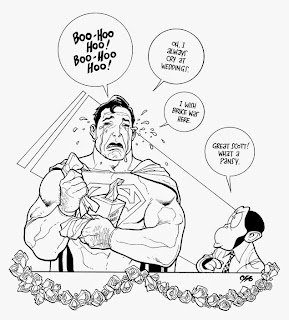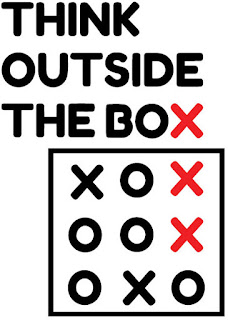We saw a couple announcements this week that are worth examining jointly, I think. First, we have a relatively simple, not-especially-surprising reveal of The Art of The Mighty Thor reprinting art by both Jack Kirby and Walt Simonson. It's the third book in the Bullpen Books line, after one focusing on John Romita Sr.'s Spider-Man and another on Kirby's Fantastic Four. That it's the third book in the line and following the same basic format -- revisiting one of Marvel's earliest heroes with some work that is pretty universally lauded -- is why it's largely unsurprising.
It's also unsurprising in that we've seen a number of book treatments along these general lines for several years, reviewing classic works through an artistic lens with a somewhere-between-academic-and-popular critical eye. There are a number of "Artist's Edition" style books, of course, and things like Chip Kidd's panel-by-panel books; these are books that may not be overloaded with essays, but offer the artwork up from a perspective that's not simply just a nice reprint but a way to examine the art differently.
The other announcement I'd like to highlight is that Oni Press put out a press release noting that they will, beginning in fall of 2026, beging a series of new titles featuring a variety of characters from the Archie Comics stories. These will not be in quite the same vein as traditional Archie fare, and sound like a re-imagining not unlike the Riverdale television series. There will also be another more-YA-focused line of graphic novels coming in 2027, apparently unrelated to either the original Archie Comics or these newer ones from Oni. And, to be clear, the titles currently being published by Archie Comics themselves will continue as they have for decades.
Now, what both of these announcements have in common is that we have long-established comic book publishers not only licensing out their characters -- which both Marvel and Archie have done for decades -- but they're licensing them out to other comic publishers. Not just for reprint rights, but for publishing entirely new material outside their direct editorial control. In that respect, this is not new for Marvel. While the "Heroes Reborn" books from 1996-97 were farmed out, they still maintained a level of publishing control, but some of the more recent books from Abrams like Fantastic Four: Full Circle and The Avengers in the Veracity Trap are not.
I've made note before -- and I still see barely anyone acknowledging this -- that Marvel officially stopped being a comic book publisher and started recognizing themselves as a character licensing company back in 2000. Over the course of just a couple years, they changed their business model pretty radically such that, by the time they were bought by Disney, Marvel only earned about 25% of their revenue from actual comics. The vast majority of their money came from licensing. That is, in fact, why Disney bought them -- they saw that Marvel had "grown up" and began to see what their real stock-in-trade was. Not unlike the revelation McDonald's had that they weren't a hamburger chain, but a real estate company. (McDonald's, if you didn't know, is the fifth largest landlord in the world; over a third of their revenue just comes from rent.)
What's interesting is to see Archie Comics make this same recognition. MLJ Magazines and Timely Comics were both founded in 1939, both started branching out into animation in the 1960s, both started seeing minor success with live-action interpretations in the 1990s... yet it took Archie nearly a quarter century longer than Marvel to see where their real value was.
There was a period in the early 2000s where people would set up comic book companies as a specific means to sideways themselves into Hollywood. Platinum Studios was probably the most nakedly open example of this. The problem they had was very much one of putting the cart before the horse. They had built up nothing to sell to Hollywood but tried making money off high-concept ideas like "cowboys and aliens." Both Marvel and Archie spent decades building up their characters with a lot of trial and error. And while Archie Comics are sometimes knocked for a house style that is largely built around Dan DeCarlo's illustration style from the 1960s, they have spent decades honing their storytelling and style of the Archie universe such that virtually everybody knows what to expect, in much the same way that everybody knows what to expect with Marvel. (Which is largely built around the storytelling -- not illustrative -- style of Kirby.)
There's more to The Art of The Mighty Thor announcement that a cool art book, and there's more to Oni's announcement than someone-other-than-Archie-Comics-to-publish-Archie-comics. In both cases, we're looking at an expansion/update of comic publishers' business models and I see a future for them sometime down the road where neither company actually publishes comics at all any more.
It's also unsurprising in that we've seen a number of book treatments along these general lines for several years, reviewing classic works through an artistic lens with a somewhere-between-academic-and-popular critical eye. There are a number of "Artist's Edition" style books, of course, and things like Chip Kidd's panel-by-panel books; these are books that may not be overloaded with essays, but offer the artwork up from a perspective that's not simply just a nice reprint but a way to examine the art differently.
The other announcement I'd like to highlight is that Oni Press put out a press release noting that they will, beginning in fall of 2026, beging a series of new titles featuring a variety of characters from the Archie Comics stories. These will not be in quite the same vein as traditional Archie fare, and sound like a re-imagining not unlike the Riverdale television series. There will also be another more-YA-focused line of graphic novels coming in 2027, apparently unrelated to either the original Archie Comics or these newer ones from Oni. And, to be clear, the titles currently being published by Archie Comics themselves will continue as they have for decades.
Now, what both of these announcements have in common is that we have long-established comic book publishers not only licensing out their characters -- which both Marvel and Archie have done for decades -- but they're licensing them out to other comic publishers. Not just for reprint rights, but for publishing entirely new material outside their direct editorial control. In that respect, this is not new for Marvel. While the "Heroes Reborn" books from 1996-97 were farmed out, they still maintained a level of publishing control, but some of the more recent books from Abrams like Fantastic Four: Full Circle and The Avengers in the Veracity Trap are not.
I've made note before -- and I still see barely anyone acknowledging this -- that Marvel officially stopped being a comic book publisher and started recognizing themselves as a character licensing company back in 2000. Over the course of just a couple years, they changed their business model pretty radically such that, by the time they were bought by Disney, Marvel only earned about 25% of their revenue from actual comics. The vast majority of their money came from licensing. That is, in fact, why Disney bought them -- they saw that Marvel had "grown up" and began to see what their real stock-in-trade was. Not unlike the revelation McDonald's had that they weren't a hamburger chain, but a real estate company. (McDonald's, if you didn't know, is the fifth largest landlord in the world; over a third of their revenue just comes from rent.)
What's interesting is to see Archie Comics make this same recognition. MLJ Magazines and Timely Comics were both founded in 1939, both started branching out into animation in the 1960s, both started seeing minor success with live-action interpretations in the 1990s... yet it took Archie nearly a quarter century longer than Marvel to see where their real value was.
There was a period in the early 2000s where people would set up comic book companies as a specific means to sideways themselves into Hollywood. Platinum Studios was probably the most nakedly open example of this. The problem they had was very much one of putting the cart before the horse. They had built up nothing to sell to Hollywood but tried making money off high-concept ideas like "cowboys and aliens." Both Marvel and Archie spent decades building up their characters with a lot of trial and error. And while Archie Comics are sometimes knocked for a house style that is largely built around Dan DeCarlo's illustration style from the 1960s, they have spent decades honing their storytelling and style of the Archie universe such that virtually everybody knows what to expect, in much the same way that everybody knows what to expect with Marvel. (Which is largely built around the storytelling -- not illustrative -- style of Kirby.)
There's more to The Art of The Mighty Thor announcement that a cool art book, and there's more to Oni's announcement than someone-other-than-Archie-Comics-to-publish-Archie-comics. In both cases, we're looking at an expansion/update of comic publishers' business models and I see a future for them sometime down the road where neither company actually publishes comics at all any more.















